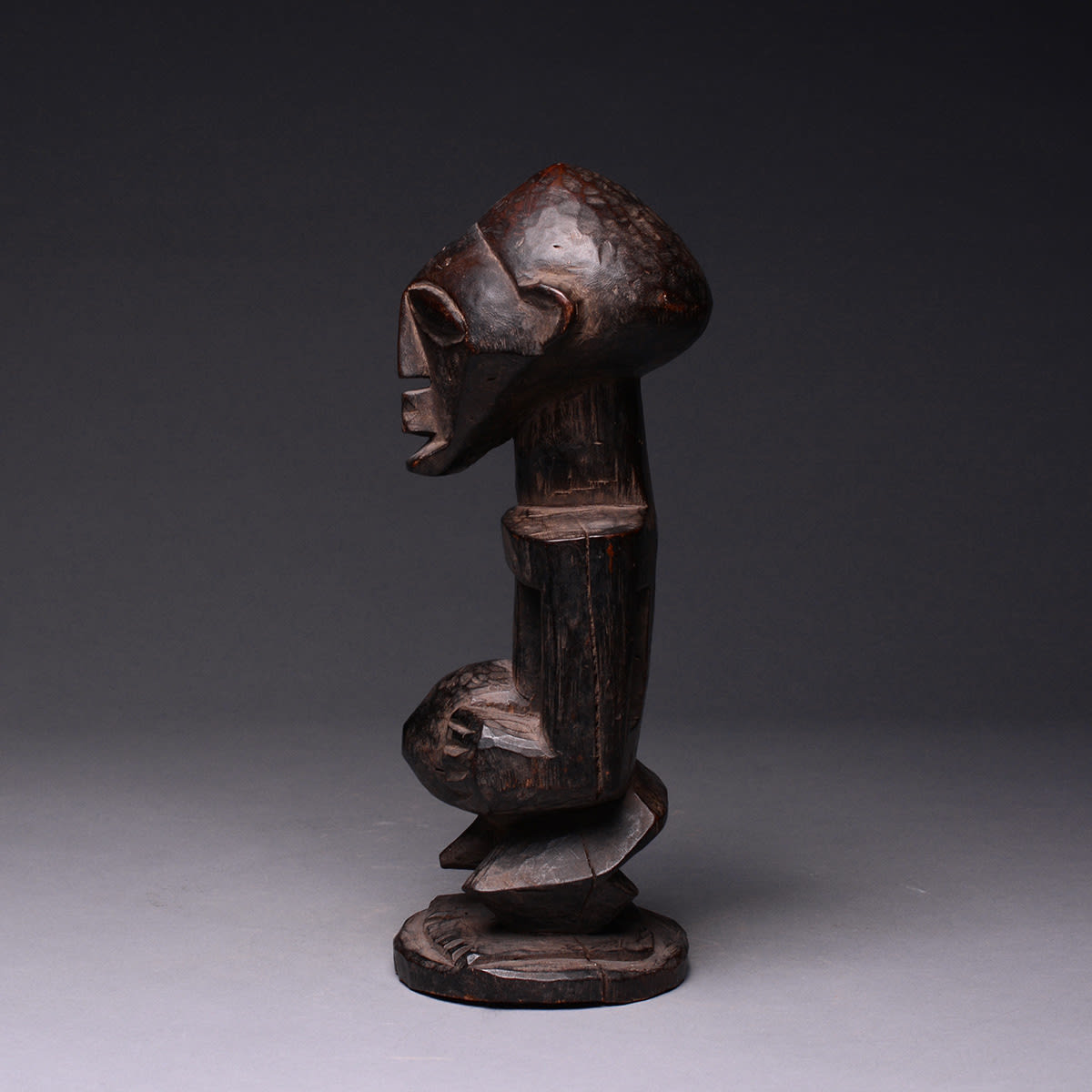Songye Wooden Bishimba Sculpture, 20th Century CE
Wood
28.6 x 10.2 cm
11 1/4 x 4 1/8 in
11 1/4 x 4 1/8 in
PF.3672 (LSO)
Further images
This angular sculpture of a standing man was made by the Songye people of what was once Zaire. It is a fairly conventional representation of a Bishimba sculpture, the significance...
This angular sculpture of a standing man was made by the Songye people of what was once Zaire. It is a fairly conventional representation of a Bishimba sculpture, the significance of which is explained below. It stands on an integral base with short, flexed legs, hands resting on a very large abdomen, block-shaped shoulders, a stubby penis and a columnar neck. The head is fairly small, with wide cheekbones narrowing to a square chin and an angled lower section denoting a beard. The eyes are coffee-bean format, with a triangular nose and a square mouth incised with an X. The body is slim from front to back and comparatively broad.
The Songye people are based in the Democratic Republic of Congo (formerly Zaire). They were founded in the 16th century following an exodus from the neighbouring Shaba area, settling near to the Lualuba River. There are around 150,000 Songye divided into subgroupings that are under the governorship of a central chief known as the Yakitenge. More local governance is in the hands of chiefs known as Sultani Ya Muti. Their economy is based upon agriculture and pastoralism.
The Songye are perhaps best known for their artworks, which are both institutional and domestic/personal in nature. Their best-known artefacts are masks created for members of the Bwadi Bwa Kifwebe. The word kifwebe means “mask” in Songye, and describes long-faced creations decorated with curvilinear designs. Crested examples are male, while plain-topped ones are female; these interact during masquerades to demonstrate the contrasting virtues of power (male) and familial values (female). The most impressive figural works are wooden sculptures that are usually decorated with feathers and other organic materials, and which are known as Bishimba. Their magical powers are contained within the horn that’s is usually inserted into the top of the head, which may contain objects such as organic residues, grave earth and biological objects such as feathers, claws or fur. The navel may also be used to situate a bilongo (packet of magical materials). The figures are often adorned with gifts in the form of furs, bells and other objects that are used to dress the figure; they also tend to receive libations, physical manifestations of appeals made for spiritual assistance.
This compact piece was probably a domestic figure. It is an attractive piece of African art.
The Songye people are based in the Democratic Republic of Congo (formerly Zaire). They were founded in the 16th century following an exodus from the neighbouring Shaba area, settling near to the Lualuba River. There are around 150,000 Songye divided into subgroupings that are under the governorship of a central chief known as the Yakitenge. More local governance is in the hands of chiefs known as Sultani Ya Muti. Their economy is based upon agriculture and pastoralism.
The Songye are perhaps best known for their artworks, which are both institutional and domestic/personal in nature. Their best-known artefacts are masks created for members of the Bwadi Bwa Kifwebe. The word kifwebe means “mask” in Songye, and describes long-faced creations decorated with curvilinear designs. Crested examples are male, while plain-topped ones are female; these interact during masquerades to demonstrate the contrasting virtues of power (male) and familial values (female). The most impressive figural works are wooden sculptures that are usually decorated with feathers and other organic materials, and which are known as Bishimba. Their magical powers are contained within the horn that’s is usually inserted into the top of the head, which may contain objects such as organic residues, grave earth and biological objects such as feathers, claws or fur. The navel may also be used to situate a bilongo (packet of magical materials). The figures are often adorned with gifts in the form of furs, bells and other objects that are used to dress the figure; they also tend to receive libations, physical manifestations of appeals made for spiritual assistance.
This compact piece was probably a domestic figure. It is an attractive piece of African art.







